tradelink-outdoor-bathroom-leaves-wallpaper
Shape and water saving the big winners in toilet trends
Phyllis, October
2015
Above image courtesy of Tradelink
The humble “toot” has come a long way since The Ancient Romans built sewers to collect the waste from the toilets of the wealthy, and even further since Stone Age farmers living in the Orkney Islands built drains under their huts for the world’s very first indoor loos.
[caption id="attachment_2856" align="alignleft" width="690"]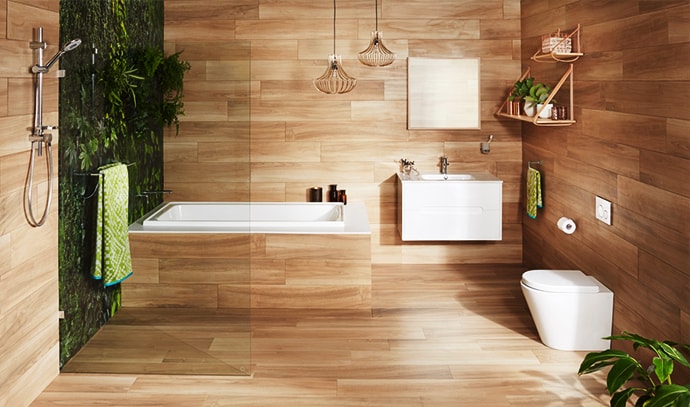 Image courtesy of Tradelink[/caption]
These days, toilets are as much a part of interior design as fancy kitchen taps and appliances. There’s even a kind of status attached to being able to sit your bottom on the latest lav. So for those about to build a new home or renovate an old one, we spoke to two of Australia’s best known suppliers in porcelain ware about the emerging trends in toilets.
[caption id="attachment_1709" align="alignleft" width="690"]
Image courtesy of Tradelink[/caption]
These days, toilets are as much a part of interior design as fancy kitchen taps and appliances. There’s even a kind of status attached to being able to sit your bottom on the latest lav. So for those about to build a new home or renovate an old one, we spoke to two of Australia’s best known suppliers in porcelain ware about the emerging trends in toilets.
[caption id="attachment_1709" align="alignleft" width="690"] Image courtesy of www.viega.com.au[/caption]
Image courtesy of www.viega.com.au[/caption]
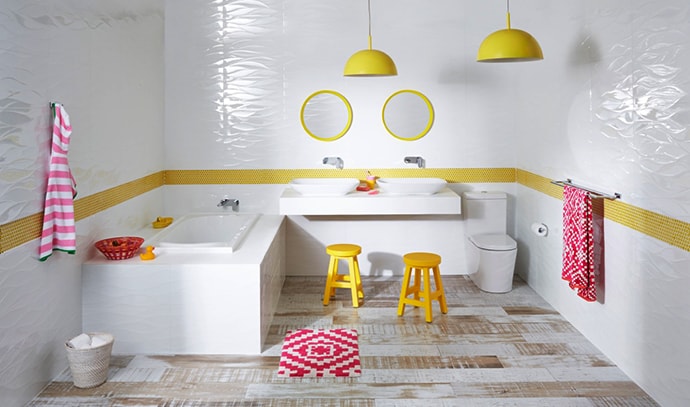 Image courtesy of Tradelink[/caption]
Tradelink National Selection Centre Manager Eamonn Lowe says while compact toilet suites are still mainstream, the wall hung models with concealed cistern are definitely the major trend. “Advantages of these are numerous,” Eamonn says. “They take far less space than conventional models - so are especially useful for compact bathrooms and en suites. Also, the wall hung models are suspended above the floor - so there is more visible floor space, which gives the perception of more space. They are also far easier to clean - less tricky bits with pipes to clean around. And should you need to access the cistern this is very easy as there is a panel (with flush control) that simply unscrews.
[caption id="attachment_2859" align="alignleft" width="690"]
Image courtesy of Tradelink[/caption]
Tradelink National Selection Centre Manager Eamonn Lowe says while compact toilet suites are still mainstream, the wall hung models with concealed cistern are definitely the major trend. “Advantages of these are numerous,” Eamonn says. “They take far less space than conventional models - so are especially useful for compact bathrooms and en suites. Also, the wall hung models are suspended above the floor - so there is more visible floor space, which gives the perception of more space. They are also far easier to clean - less tricky bits with pipes to clean around. And should you need to access the cistern this is very easy as there is a panel (with flush control) that simply unscrews.
[caption id="attachment_2859" align="alignleft" width="690"]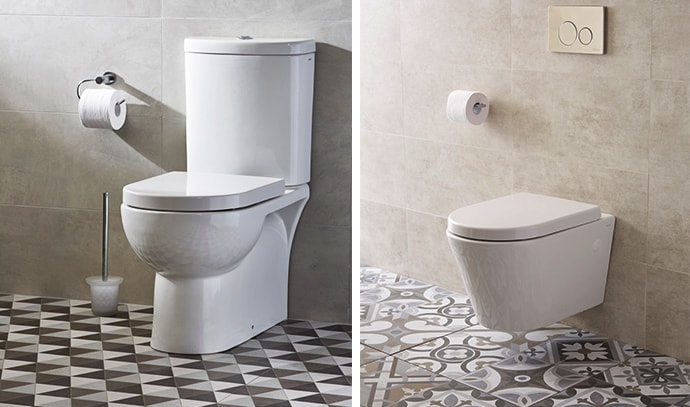 Image courtesy of Tradelink - (left - by-the-wall toilet) Raymor Edge and (right - wall hung toilet) Byron[/caption]
“And finally, the wall hung toilet with concealed cistern is now more affordable. The Byron wall hung model is about $799 with the same model as a wall faced design (concealed cistern and the toilet suite sits on the floor) at $699.”
[caption id="attachment_2853" align="alignleft" width="690"]
Image courtesy of Tradelink - (left - by-the-wall toilet) Raymor Edge and (right - wall hung toilet) Byron[/caption]
“And finally, the wall hung toilet with concealed cistern is now more affordable. The Byron wall hung model is about $799 with the same model as a wall faced design (concealed cistern and the toilet suite sits on the floor) at $699.”
[caption id="attachment_2853" align="alignleft" width="690"]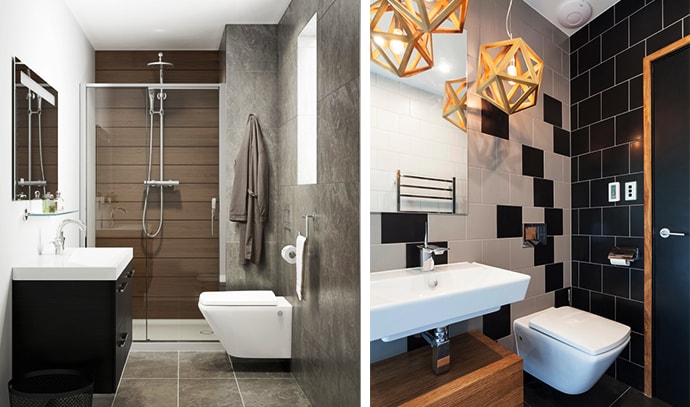 Images courtesy of Tradelink (left - Escale wall hung toilet) and Kohler (right)[/caption]
Eamonn says soft close seats are also another strong trend – and that these do make an enormous difference to the experience! Tradelink is including these as standard in most of its toilets.
Images courtesy of Tradelink (left - Escale wall hung toilet) and Kohler (right)[/caption]
Eamonn says soft close seats are also another strong trend – and that these do make an enormous difference to the experience! Tradelink is including these as standard in most of its toilets.
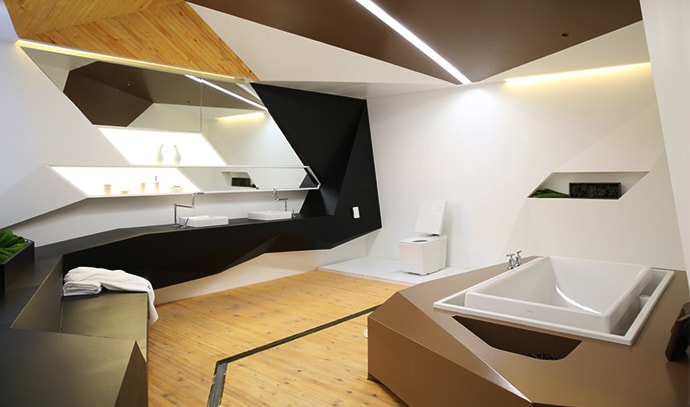 Image courtesy of Kohler[/caption]
Kohler National Product Manager Tom Casper says toilet design is consistently about saving as much water as possible. “In the 1970s, each toilet flush used about 7.5 litres of water,” he says. “Our toilets today use three litres for a half flush and 4.5 litres for a full flush and we are constantly seeking to reduce this further.”
[caption id="attachment_2848" align="alignleft" width="690"]
Image courtesy of Kohler[/caption]
Kohler National Product Manager Tom Casper says toilet design is consistently about saving as much water as possible. “In the 1970s, each toilet flush used about 7.5 litres of water,” he says. “Our toilets today use three litres for a half flush and 4.5 litres for a full flush and we are constantly seeking to reduce this further.”
[caption id="attachment_2848" align="alignleft" width="690"]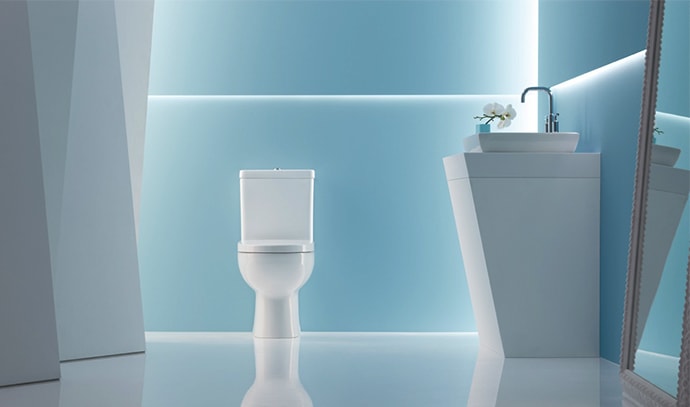 Image courtesy of Kohler[/caption]
Image courtesy of Kohler[/caption]
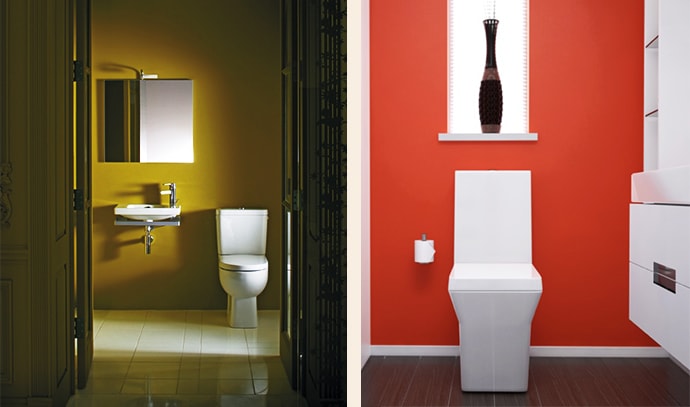 Images courtesy of Kohler - (left) Reach and (right) Reve[/caption]
“Shape is very important - consumers now want toilets that match the profile of other major items within the bathroom - such as freestanding bath and/or basin. So there are distinctly square shapes available (Reve and Escale) and very rounded curvaceous shapes (Viragio, Panache).
[caption id="attachment_2849" align="alignleft" width="690"]
Images courtesy of Kohler - (left) Reach and (right) Reve[/caption]
“Shape is very important - consumers now want toilets that match the profile of other major items within the bathroom - such as freestanding bath and/or basin. So there are distinctly square shapes available (Reve and Escale) and very rounded curvaceous shapes (Viragio, Panache).
[caption id="attachment_2849" align="alignleft" width="690"]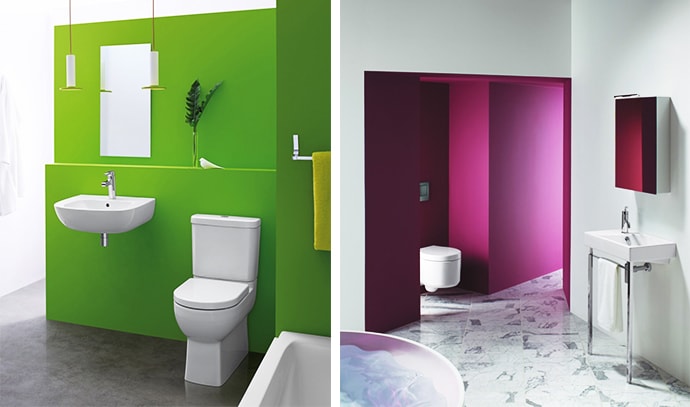 Images courtesy of Kohler - (left - by the wall) Reach and (right - wall hung) Viragio[/caption]
“Water conservation is something very much on trend with a four star WELS rating with dual flush 4.5/3L is now the standard.”
[caption id="attachment_2855" align="alignleft" width="690"]
Images courtesy of Kohler - (left - by the wall) Reach and (right - wall hung) Viragio[/caption]
“Water conservation is something very much on trend with a four star WELS rating with dual flush 4.5/3L is now the standard.”
[caption id="attachment_2855" align="alignleft" width="690"]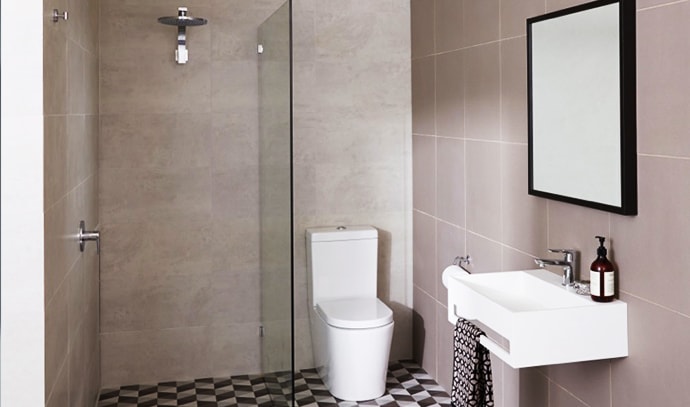 Image courtesy of Tradelink[/caption]
Image courtesy of Tradelink[/caption]
 Image courtesy of Tradelink[/caption]
These days, toilets are as much a part of interior design as fancy kitchen taps and appliances. There’s even a kind of status attached to being able to sit your bottom on the latest lav. So for those about to build a new home or renovate an old one, we spoke to two of Australia’s best known suppliers in porcelain ware about the emerging trends in toilets.
[caption id="attachment_1709" align="alignleft" width="690"]
Image courtesy of Tradelink[/caption]
These days, toilets are as much a part of interior design as fancy kitchen taps and appliances. There’s even a kind of status attached to being able to sit your bottom on the latest lav. So for those about to build a new home or renovate an old one, we spoke to two of Australia’s best known suppliers in porcelain ware about the emerging trends in toilets.
[caption id="attachment_1709" align="alignleft" width="690"] Image courtesy of www.viega.com.au[/caption]
Image courtesy of www.viega.com.au[/caption]
Space saving
German brand Viega has noticed an increase in demand for concealed cisterns and has recently introduced a new slim-line cistern and designer flush plates to the Australian market. The Viega MonoTec cistern has a WELS 4-star rating based on a 3 and 4.5 litre flush, with the capability to increase it up to 6L for a large flush. The cisterns can also be combined with Viega’s extensive range of award-winning flush plate designs – one of the most comprehensive and diverse ranges available. “Regardless of a bathroom’s architectural style, Viega has a flush plate which can fit harmoniously into the design of any bathroom,” says Viega’s Robert Hardgrove. “They’re designed to match a wide array of ceramics and taps.” Viega’s flush plates come in a choice of short or long, chrome, stainless steel, plastic or glass. [caption id="attachment_2852" align="alignleft" width="690"] Image courtesy of Tradelink[/caption]
Tradelink National Selection Centre Manager Eamonn Lowe says while compact toilet suites are still mainstream, the wall hung models with concealed cistern are definitely the major trend. “Advantages of these are numerous,” Eamonn says. “They take far less space than conventional models - so are especially useful for compact bathrooms and en suites. Also, the wall hung models are suspended above the floor - so there is more visible floor space, which gives the perception of more space. They are also far easier to clean - less tricky bits with pipes to clean around. And should you need to access the cistern this is very easy as there is a panel (with flush control) that simply unscrews.
[caption id="attachment_2859" align="alignleft" width="690"]
Image courtesy of Tradelink[/caption]
Tradelink National Selection Centre Manager Eamonn Lowe says while compact toilet suites are still mainstream, the wall hung models with concealed cistern are definitely the major trend. “Advantages of these are numerous,” Eamonn says. “They take far less space than conventional models - so are especially useful for compact bathrooms and en suites. Also, the wall hung models are suspended above the floor - so there is more visible floor space, which gives the perception of more space. They are also far easier to clean - less tricky bits with pipes to clean around. And should you need to access the cistern this is very easy as there is a panel (with flush control) that simply unscrews.
[caption id="attachment_2859" align="alignleft" width="690"] Image courtesy of Tradelink - (left - by-the-wall toilet) Raymor Edge and (right - wall hung toilet) Byron[/caption]
“And finally, the wall hung toilet with concealed cistern is now more affordable. The Byron wall hung model is about $799 with the same model as a wall faced design (concealed cistern and the toilet suite sits on the floor) at $699.”
[caption id="attachment_2853" align="alignleft" width="690"]
Image courtesy of Tradelink - (left - by-the-wall toilet) Raymor Edge and (right - wall hung toilet) Byron[/caption]
“And finally, the wall hung toilet with concealed cistern is now more affordable. The Byron wall hung model is about $799 with the same model as a wall faced design (concealed cistern and the toilet suite sits on the floor) at $699.”
[caption id="attachment_2853" align="alignleft" width="690"] Images courtesy of Tradelink (left - Escale wall hung toilet) and Kohler (right)[/caption]
Eamonn says soft close seats are also another strong trend – and that these do make an enormous difference to the experience! Tradelink is including these as standard in most of its toilets.
Images courtesy of Tradelink (left - Escale wall hung toilet) and Kohler (right)[/caption]
Eamonn says soft close seats are also another strong trend – and that these do make an enormous difference to the experience! Tradelink is including these as standard in most of its toilets.
Softer shapes
“Shapes of toilets have changed over the past couple of years with a gradual progression towards softer shapes, with more organic curves so there are no sharp angles to trap dust or dirt. Overall this makes cleaning a lot easier. Not only has the shape been streamlined but water usage has been refined with toilets such as the Byron featuring a 4 star WELS,” says Eamonn. [caption id="attachment_2851" align="alignleft" width="690"] Image courtesy of Kohler[/caption]
Kohler National Product Manager Tom Casper says toilet design is consistently about saving as much water as possible. “In the 1970s, each toilet flush used about 7.5 litres of water,” he says. “Our toilets today use three litres for a half flush and 4.5 litres for a full flush and we are constantly seeking to reduce this further.”
[caption id="attachment_2848" align="alignleft" width="690"]
Image courtesy of Kohler[/caption]
Kohler National Product Manager Tom Casper says toilet design is consistently about saving as much water as possible. “In the 1970s, each toilet flush used about 7.5 litres of water,” he says. “Our toilets today use three litres for a half flush and 4.5 litres for a full flush and we are constantly seeking to reduce this further.”
[caption id="attachment_2848" align="alignleft" width="690"] Image courtesy of Kohler[/caption]
Image courtesy of Kohler[/caption]
Popular design
“Kohler has led the field in toilet innovation, recognising the growing consumer demand for more choice in what has been an everyday item that has remained pretty much the same since it went mainstream in the late 1800s,” says Tony. “The company has been focused on water conservation, shape and ease of use. Their view of the trend is that wall faced and wall hung models are now the most popular - these have concealed cisterns and either are suspended from the wall (above the floor) or sit on the floor. Either way they take far less room than the conventional toilet. [caption id="attachment_2850" align="alignleft" width="690"] Images courtesy of Kohler - (left) Reach and (right) Reve[/caption]
“Shape is very important - consumers now want toilets that match the profile of other major items within the bathroom - such as freestanding bath and/or basin. So there are distinctly square shapes available (Reve and Escale) and very rounded curvaceous shapes (Viragio, Panache).
[caption id="attachment_2849" align="alignleft" width="690"]
Images courtesy of Kohler - (left) Reach and (right) Reve[/caption]
“Shape is very important - consumers now want toilets that match the profile of other major items within the bathroom - such as freestanding bath and/or basin. So there are distinctly square shapes available (Reve and Escale) and very rounded curvaceous shapes (Viragio, Panache).
[caption id="attachment_2849" align="alignleft" width="690"] Images courtesy of Kohler - (left - by the wall) Reach and (right - wall hung) Viragio[/caption]
“Water conservation is something very much on trend with a four star WELS rating with dual flush 4.5/3L is now the standard.”
[caption id="attachment_2855" align="alignleft" width="690"]
Images courtesy of Kohler - (left - by the wall) Reach and (right - wall hung) Viragio[/caption]
“Water conservation is something very much on trend with a four star WELS rating with dual flush 4.5/3L is now the standard.”
[caption id="attachment_2855" align="alignleft" width="690"] Image courtesy of Tradelink[/caption]
Image courtesy of Tradelink[/caption]



